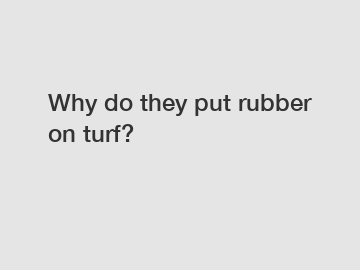Why do they put rubber on turf?
Why Do They Put Rubber on Turf?
Artificial turf has become the go-to choice for many sports fields and recreational spaces. It offers a low-maintenance solution that can withstand heavy use in all weather conditions. But have you ever wondered why rubber is added to these synthetic grass fields? In this article, we'll explore the reasons behind the inclusion of rubber in artificial turf and shed light on its significance.
One of the primary purposes of adding rubber to turf is to improve player safety. The rubber infill acts as a shock absorber when athletes run, jump, or fall on the field. This helps reduce the impact on their joints and minimizes the risk of injuries, such as sprained ankles or knee strains. Unlike natural grass, which can become hard and compacted over time, the rubber infill provides a reliable cushioning effect, creating a more forgiving surface for players.

Another notable benefit of the rubber infill is its contribution to the overall stability and firmness of the field. The rubber particles help anchor the synthetic grass fibers, preventing them from shifting or becoming unevenly compacted. This ensures a consistent playing surface with a proper ball bounce and predictable footing, allowing athletes to showcase their skills without worrying about unpredictable variations across the field.
Additionally, rubber infill is essential for optimizing the drainage capabilities of synthetic turf. It allows water to permeate through to the ground underneath, ensuring effective water management during heavy rainfall. This feature not only helps maintain the integrity of the turf but also allows the field to be used immediately after inclement weather. Compared to natural grass, which can become muddy and slippery in wet conditions, the rubber infill ensures a safer and more playable surface, reducing the likelihood of slips and falls.
Environmental sustainability is another crucial aspect of using rubber infill. The majority of rubber infill used in modern synthetic turf fields consists of recycled materials, such as old car tires. This repurposing of rubber helps minimize waste and provides an eco-friendly solution for sports facilities. By opting for rubber infill, organizations contribute to reducing the number of discarded tires in landfills while also benefiting from an efficient and durable playing surface.
Moreover, the rubber infill allows for increased durability and longevity of the turf. Without it, synthetic grass fibers may flatten, wear out, and lose their vibrant appearance over time. The rubber particles add structure and resilience to the turf, enhancing its ability to withstand heavy foot traffic and frequent usage. This longevity translates to cost savings for organizations, as they can avoid frequently replacing or renovating sports fields, which can be a significant investment.
Aesthetically, the rubber infill also plays a significant role. It helps replicate the natural grass look and feel, providing a visually appealing and pleasant environment for both athletes and spectators. Without the rubber particles, the artificial turf may appear flat and lifeless, lacking the depth and texture resembling real grass. The rubber infill not only improves the appearance but also adds a realistic element to the playing experience.
However, it is essential to address concerns raised about potential health risks associated with rubber infill, such as the release of chemicals and heat absorption. Over the years, numerous studies have been conducted to assess the safety of rubber infill, and the results have generally shown that the levels of chemicals present are below health risk thresholds. Nonetheless, it is crucial to regularly maintain and monitor the turf, ensuring safe and healthy playing conditions.
In conclusion, the addition of rubber to turf is a crucial factor in ensuring player safety, stability, drainage, and durability of synthetic grass fields. It acts as a shock absorber, provides stability, enhances drainage, and improves field longevity. Furthermore, it contributes to environmental sustainability by utilizing recycled materials. Although concerns about health risks have been raised, studies have supported the overall safety of rubber infill used in synthetic turf fields. Overall, the incorporation of rubber in artificial turf combines practicality, sustainability, and aesthetics, making it an essential element of modern sports field design.
Want more information on nbr latex suppliers, phosphate modified polyacrylate emulsion, What are the uses of acrylic emulsion?? Feel free to contact us.



Comments
0